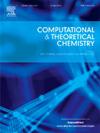5-氟尿嘧啶给药金属掺杂硼球B40的计算筛选
IF 3
3区 化学
Q3 CHEMISTRY, PHYSICAL
引用次数: 0
摘要
本研究利用密度泛函理论(DFT)系统地研究了B40M (M = K ~ Zn)纳米笼与5-氟尿嘧啶(5-Fu)抗癌药物的相互作用。探索了不同掺杂模式和自旋多重性,以筛选出最稳定的B40M。在这些硼基纳米笼中,B40M (M = K, Ti, V和Fe)对5-Fu表现出显著的吸附能(Ead =−18.91 ~−20.41 kcal/mol)。发现B40K与5-Fu之间形成的KO2键具有典型的离子特征,而B40M (M = Ti, V, Fe)与5-Fu之间形成的M- o键具有离子和共价键的特征。在弱酸性环境下,5-Fu@B40V的Ead值从−20.34 kcal/mol下降到−9.61 kcal/mol。基于这些发现,B40M (M = K, Ti, V, Fe)纳米笼被确定为5-Fu甚至其他药物的有前途的药物载体。本文章由计算机程序翻译,如有差异,请以英文原文为准。

Computational screening of metal-doped borospherene B40 for 5-fluorouracil drug delivery
The interaction between B40M (M = K ∼ Zn) nanocages and 5-fluorouracil (5-Fu) anticancer drug has been systematically investigated using density functional theory (DFT) in this study. The different doping modes and spin multiplicity have been explored to screen out the most stable B40M. Among these considered boron-based nanocages, B40M (M = K, Ti, V, and Fe) exhibit remarkable adsorption energies (Ead = −18.91 ∼ −20.41 kcal/mol) toward 5-Fu. It is found that the K![]() O2 bond formed between B40K and 5-Fu shows typical ionic characteristics, while the M-O bonds between B40M (M = Ti, V, and Fe) and 5-Fu exhibit both of ionic and covalent bonding characteristics. Interestingly, the Ead value of 5-Fu@B40V decreases from −20.34 to −9.61 kcal/mol in a weakly acidic environment. Based on these findings, the B40M (M = K, Ti, V, and Fe) nanocages are identified as promising drug carriers for 5-Fu and even other drugs.
O2 bond formed between B40K and 5-Fu shows typical ionic characteristics, while the M-O bonds between B40M (M = Ti, V, and Fe) and 5-Fu exhibit both of ionic and covalent bonding characteristics. Interestingly, the Ead value of 5-Fu@B40V decreases from −20.34 to −9.61 kcal/mol in a weakly acidic environment. Based on these findings, the B40M (M = K, Ti, V, and Fe) nanocages are identified as promising drug carriers for 5-Fu and even other drugs.
求助全文
通过发布文献求助,成功后即可免费获取论文全文。
去求助
来源期刊

Computational and Theoretical Chemistry
CHEMISTRY, PHYSICAL-
CiteScore
4.20
自引率
10.70%
发文量
331
审稿时长
31 days
期刊介绍:
Computational and Theoretical Chemistry publishes high quality, original reports of significance in computational and theoretical chemistry including those that deal with problems of structure, properties, energetics, weak interactions, reaction mechanisms, catalysis, and reaction rates involving atoms, molecules, clusters, surfaces, and bulk matter.
 求助内容:
求助内容: 应助结果提醒方式:
应助结果提醒方式:


